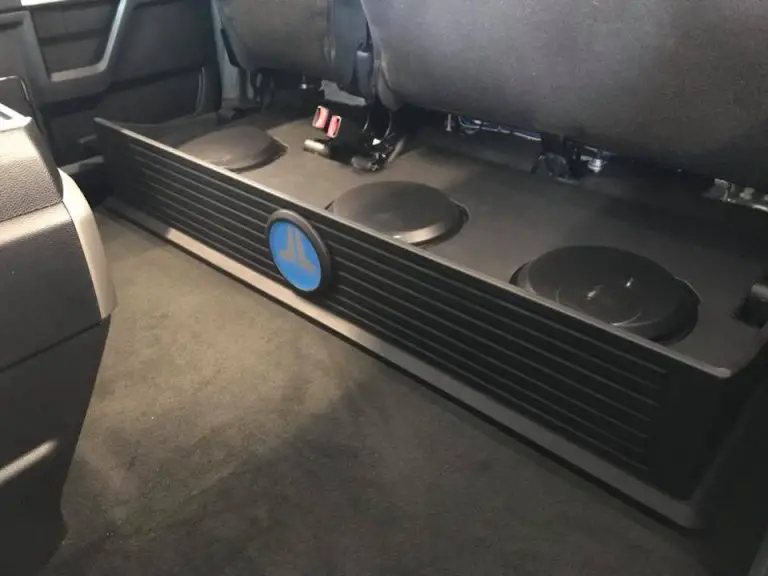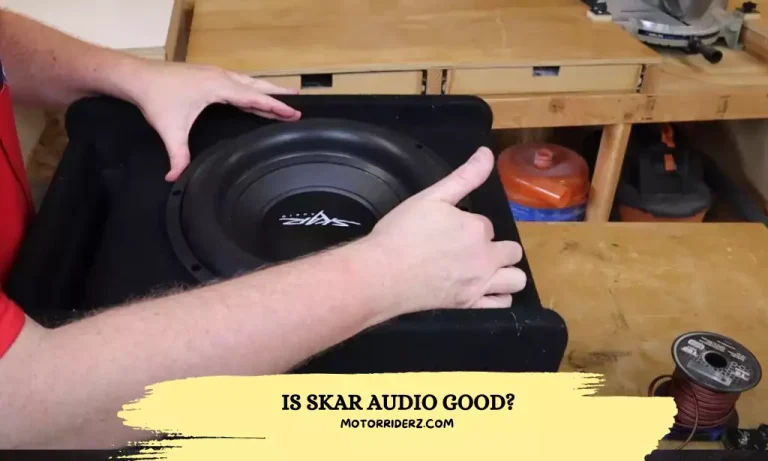Why Is My Subwoofer Not Working?
If your subwoofer is not working, perform a quick test on the wires to check for any issues. Make sure the subwoofer is securely plugged into a power source and check the outlets, power cable, and fuse.
Ensure that all input cables are tightly plugged in and not loose, as loose connections can hinder signal transmission. If the subwoofer still isn’t working, consider inspecting the fuse or checking if the speaker wire is failing. Overdriving or driving a distorted signal continuously to the subwoofer can also lead to subwoofer failure.
Addressing Power Issues
If your subwoofer is not working, there are several potential causes to consider. First, check the wires to ensure they are functioning properly. Additionally, make sure the subwoofer is securely plugged into a power source and that the fuse is not blown.
If the issue persists, double-check the connection to your audio system and ensure all cables are secure. Troubleshooting these potential issues should help address the problem and get your subwoofer working again.
| Addressing Power Issues |
|
Ensuring the subwoofer is plugged in Perform a quick test on the wires to check that they work. Most subwoofers have a “standby” LED that glows to indicate active power. If it’s not lit, check that the subwoofer is securely plugged into a wall socket, surge protector, or power strip. |
|
Checking power outlets and surge protectors Inspect the power outlet or surge protector where the subwoofer is plugged in. Ensure that it is functioning properly by plugging in another device. If the outlet or surge protector is faulty, it may not be supplying power to the subwoofer. |
|
Inspecting the subwoofer’s power cable and fuse Examine the power cable connecting the subwoofer to the power source. Look for any damage or frayed wires that may be causing a power issue. Additionally, check the fuse of the subwoofer to see if it has blown. Replace the fuse if necessary. |
Connectivity And Input Checks
|
When troubleshooting why your subwoofer is not working, it’s important to start by checking the connectivity and input cables. Here are a few steps you can take:
If any cables are loose or damaged, it can hinder the proper transmission of signals and result in the subwoofer not working. Make sure to check all connections and cables before proceeding with further troubleshooting steps. |
Signal And Setting Adjustments
| Why Is My Subwoofer Not Working? | |
| Signal and Setting Adjustments | |
| – Assessing the receiver or amplifier settings |
If you are experiencing issues with your subwoofer not working, there are several things you can check to identify and resolve the problem. To start, perform a quick test on the wires to ensure they are functioning properly. Check the outlets, power cable, and fuse to ensure they are not the source of the issue. Most subwoofers have a “standby” LED that indicates active power, so make sure it is lit. If not, ensure that the subwoofer is securely plugged into a wall socket, surge protector, or power strip.
If the subwoofer still isn’t working properly, you can assess the receiver or amplifier settings. Check if all the input cables are tightly plugged in, as loose connections can hinder the proper transmission of signals. Additionally, inspect the fuse of the subwoofer to ensure it is not blown.
Another factor to consider is the speaker patterns and configurations. Make sure that the subwoofer is properly connected to your audio system and that all the cables are secure. If you have tried these troubleshooting steps and the subwoofer still isn’t working, it may be necessary to consult the instruction manual of your equipment or seek professional assistance.
Investigating Internal Components
- Inspecting the subwoofer’s internal speaker wire and coils
- Checking for visual signs of damage to the speaker cone
- Assessing the functionality of the built-in amplifier
In order to troubleshoot why your subwoofer is not working, it is important to investigate its internal components. Start by inspecting the speaker wire and coils inside the subwoofer. Make sure that they are properly connected and not damaged. Next, visually examine the speaker cone for any signs of wear or tear. If there is noticeable damage, it may need to be replaced. Lastly, assess the functionality of the built-in amplifier. Ensure that it is receiving power and transmitting sound signals correctly. If necessary, consult the user manual or contact customer support for further assistance.
Hardware And Firmware Solutions
Why Is My Subwoofer Not Working? If your subwoofer is not working, there are a few hardware and firmware solutions you can try. First, perform a quick test on the wires to check if they are working properly. Check the outlets, power cable, and fuse to ensure they are not the issue. Make sure the subwoofer is securely plugged into a wall socket, surge protector, or power strip. Additionally, check if all the input cables are tightly plugged in as loose connections may hinder proper signal transmission. If these steps don’t solve the problem, consider a factory reset for the subwoofer if applicable. Another option is to update the receiver’s or amplifier’s firmware. Sometimes a firmware update can fix compatibility issues between the subwoofer and the receiver. Check the manual or the manufacturer’s website for instructions on how to update the firmware.
External Influences And Interferences
To troubleshoot why your subwoofer is not working, there are a few steps you can follow. Start by performing a quick test on the wires to ensure they are functioning properly. Check the outlets, power cable, and fuse to ensure they are not the source of the issue. If your subwoofer has a “standby” LED, check that it is lit, indicating active power. Ensure that the subwoofer is securely plugged into a wall socket, surge protector, or power strip. Next, check that all input cables are tightly plugged in, as loose connections can hinder signal transmission. You can also inspect the fuse of the subwoofer and check for any issues. Additionally, ensure that the subwoofer is properly connected to your audio system and that all cables are secure. Troubleshooting common receiver issues and trying different speaker settings can also help resolve the problem. If you continue to experience issues, consider consulting the instruction manual or seeking professional assistance.
References:
– Lifewire
– ElectronicsHub
– YouTube – Subwoofer Troubleshooting
– Quora – How can I repair a subwoofer that just suddenly stopped working?
– ecoustics.com – Subwoofer stopped working all of the sudden
– BoomSpeaker
– Sony USA – How to troubleshoot no sound coming from an active subwoofer
– Klipsch Support – Common Receiver Issues for Subwoofers
Common Electrical Malfunctions
If you’re experiencing issues with your subwoofer not working, there are a few common electrical malfunctions that you can troubleshoot. One possible issue is blown fuses within the subwoofer. Perform a quick test on the wires to ensure they are functioning properly. Check outlets, power cable, and fuse to make sure they are not the culprit behind the problem.
Overheating can also be a factor affecting the performance of your subwoofer. Identifying overheating issues and their impact is crucial in resolving the problem. Inspect the fuse of the subwoofer and make sure it is in good condition.
To further troubleshoot the issue, check if all the input cables are tightly plugged in. Loose connections can hinder the proper transmission of signals. If the problem persists, consulting the manufacturer’s instructions or reaching out to a professional might be necessary.
Sound System Integration
When it comes to subwoofer integration with the sound system, ensuring proper compatibility between the subwoofer and receiver is crucial. One common issue is the subwoofer not working despite receiving power from the amplifier.
To troubleshoot this problem, start by performing a quick test on the wires to ensure they are functioning correctly. Check the outlets, power cable, and fuse, as a faulty connection or blown fuse can prevent the subwoofer from working. Look for a “standby” LED on the subwoofer, which should be lit to indicate active power. If it’s not illuminated, double-check the subwoofer’s connection to the power source.
Inspect the input cables connecting the subwoofer to the sound system. Loose cables can hinder proper signal transmission, resulting in the subwoofer not functioning correctly. Ensure all cables are securely plugged in and tightened.
If these troubleshooting steps do not resolve the issue, consult the instruction manual of your sound system or consider seeking professional assistance to address any compatibility or wiring issues.
Preventative Measures And Maintenance
- Perform a quick test on the wires to check that they work.
- Check outlets, power cable, and fuse.
- Most subwoofers have a “standby” LED that glows to indicate active power. If it’s not lit, check that the subwoofer is securely plugged into a wall socket, surge protector, or power strip.
- First, check if all the input cables are tightly plugged in.
- Inspect the fuse of the subwoofer.
- Make sure that the subwoofer is properly connected to your audio system and that all the cables are secure.
- If your car subwoofer randomly stops working, check the connections and restart the car.
- If the subwoofer turns off at low volume, try adjusting the settings.
- Check the tinsel leads and coils of the subwoofer if it suddenly stops working.
- Verify that the subwoofer is enabled in the Speaker Pattern (SP) settings.
- A failing speaker wire or faulty speakers can cause an unresponsive subwoofer.
- Trying a different speaker setting may resolve the issue.
- Make sure the subwoofer or “sub out” channel is enabled/active within the receiver settings.
If you are still experiencing problems with your subwoofer, it is advisable to consult the instruction manual or seek professional assistance for further troubleshooting.
Conclusion
Woofer not working? There can be several reasons why your subwoofer is not functioning properly. First, check the wires to ensure they are connected correctly. Additionally, make sure the subwoofer is securely plugged into a power source and that the fuse is not blown.
Loose or incorrect connections, as well as overdriving the subwoofer, can also cause it to fail. Troubleshooting these common issues can help you determine the cause and potentially fix the problem. Remember to always refer to the user manual or seek professional assistance if needed.


